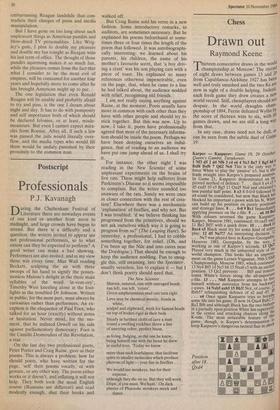Chess
Drawn out
Raymond Keene
Thirteen consecutive draws in the world 1 championship at Moscow! The record of eight draws between games 13 and 20 from Capablanca-Alekhine 1927 has be well and truly smashed and the two Ks are now in sight of a double helping. Indeed, each fresh game they draw creates a nevi world record. Still, chessplayers should riot despair. In the world draughts chair' pionship of 1894, Ferrie defeated Wyllie by the score of thirteen wins to six, with 69 games drawn, and we are still a long we from that.
In any case, draws need not be dull, as can be seen from the subtle duel of Gale 19:
Karpov — Kasparov: Game 19, 29 October; Queen's Gambit, Tartakower. 1 Nf3 d5 2 d4 Nf6 3 c4 e6 4 Nc3 Be7 5 Bg5 h66 Bxf6 Bxf6 7 Qd2 Nc6 This is the only way 1° force White to play the 'passive' e3, but it als° leads straight into Karpov's prepared analysis. In Game 21, Kasparov demonstrated an ir11,; proved method of defence: 7 . . . dxc4 8 e4 c5 7 d5 exd5 10 e5 Bg5 11 Qxd5 Nc6 and obtained a less painful half point. 8 e3 8 0-0-0 followed bY e4 could be considered, but now that Black ha5 blocked his important c-pawn with his N. Whil can build up his position on purely position and strategic lines. 8 . . . 0-0 9 11c1 Immediate/Y applying pressure on the c-file. 9 . . . a6 10 Be2 With colours reversed the game Kasparo,,v' Karpov, Moscow 1981, continued: 10 cxd5 excl; 11 Be2 Bf5! with a quick draw. 10 . . . dxc4 Bxc4 e5 Black must try for some kind of activ,e, play. 12 d5 Na7!? An interesting decision. 14 . . . Ne7 was played here in Karpov-Georgadz!' Hanover 1983. Georgadze, by the way, ,I5, working as one of Karpov's seconds. 13 QC4. Played very much in the unhurried style of the world champion. This looks like an improve' ment on the game Lerner-Vaganian, 50th USSR Championship, Moscow 1983, which continued: 13 Ne4 Bf5 14 Nc5 b6 15 Nxa6 c5 with an unclear position. 13 Qc2 prevents . . . Bf5 and cancer': trates White's forces along the all-importan' c-file. 13 . . . Nb5 Kasparov attempts to freed himself without assistance from his backwar,, c-pawn. 14 Nxb5 axb5 15 Bb3! Not, of course, Bxb5? relinquishing defence of a2 and d5. 1' . . -e4 Once again Kasparov tries to breath?, some life into his game. If now 16 Coxe4 Bxb2 1 Rc2 Bf6 and although Black has the two bishoPs in a partially open position White has superioritYe in the centre and attacking chances along. K-side. The most noticeable feature of 01, game, though, is Karpov's determination keep Kasparov's dangerous tactical flair in cheer'
Position after 18 . . . Qxd4
and to hold his opponent safely at bay. The world champion is not prepared to allow the Slightest tactical chance (e.g. after 16 Qxe4). 16 Nd4 Bxd4 17 exd4 c6! The best way of ridding himself of his problems on c7. If 17 . . . Qg5 18 0-0 Bf5 (18. . . Bh3? 19 Qxe4 and Qf3) 19 Qxc7 Rac8 20 h4! with advantage to White. 18 dxc6 Qxd4 (diagram) 19 0-0 Another real `Karpov move' eliminating any danger to himself. A much more ambitious try is 19 c7!?, but after 19
• . 8d7 (intending . Bc6) or 19 . . Ra6
(intending . . .Rc6) Black enjoys a measure of counterplay. Karpov instead strives for small but clear advantages — exactly like the hero of his early years, Capablanca. 19 . . . bxc6 20 Qxc6 Rd7 21 Qd5 Qxd5 22 Bxd5 Ra6 With artistic subtlety Karpov has converted his first strategic plus (pressure on the c-file against the c7 pawn) Into a second, his 0-side pawn majority. This Majority, one of Capablanca's favourite Weapons, has the potential to create a distant passed pawn which, if all the pieces are ex- changed into a K and P endgame, will almost always constitute a decisive advantage. 23 Rfdl lie6 24 a3 Safeguarding the a-pawn. 24. . . Bxd5 _45 Rxd5 Rb8 26 Rd4 Ra4 27 Rcd1 Rc8 28 Kfl Kc2 29 R4d2 Rxd2 30 Rxd2 Rc4 31 Ke2 b4 Black actually co-operates in the production of White's gassed a-pawn, but otherwise the P on b5 could ccome a target. 32 Kdl bxa3 33 bxa3 Ra4 34 1(52 f5 Black rapidly mobilises his own K-side Pawn majority. 35 Kc2 f4 36 Kb3 Rd4 37 Ral A strange-looking move, but the only way to keep Winning chances alive. If 37 a4 e3 38 fxe3 fxe3 39 a5 Re4 40Re2 Kf7 41 a6 Re6 42 a7 Rb6+ draws. 37 • • . IC17 38 a4 e3 39 Kc3 Rd8 40 fxe3 fxe3 41 ROL Ra8 42 Kb3 Rb8+ 43 Kc2 Ra8 44 Rfl + Ke6 The sealed move, and a draw was agreed Without further play. 44 . . . Kg6 had been universally expected, but this is also adequate:
Ral Rd8 46 a5 e2 47 a6 Rd7 or 46 Ra3 Ptd2+ Kc3 Rxg2 48 a5 e2 49 Kd2 el + =Q. Finally, 45 Ral Rd8 46 a5 e2 47 Rel Ra8 48 Rxe2+ Kf6.
After their mammoth sequence of draws it is now clear that neither Karpov nor
Kasparov will be able to represent the USSR in the coming Olympiad, starting at Thessaloniki on 18 Nov. With an English Side comprising Miles, Nunn, Speelman,
Mestel, Chandler and Short, this is surely Our chance for the Gold Medals!















































 Previous page
Previous page